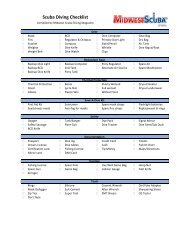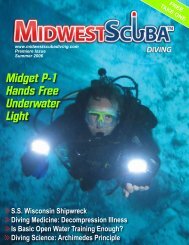NAUI - 50 Years of Diving History and still Growing! - Midwest Scuba ...
NAUI - 50 Years of Diving History and still Growing! - Midwest Scuba ...
NAUI - 50 Years of Diving History and still Growing! - Midwest Scuba ...
- No tags were found...
Create successful ePaper yourself
Turn your PDF publications into a flip-book with our unique Google optimized e-Paper software.
DIVING SCIENCE: HOW REGULATORS WORK(shown in figure 1) opens. High-pressure gasfrom chamber C rushes into chamber A until,again, the pressure in A is large enough t<strong>of</strong>orce the valve stem back to the right againstthe seat. The gas supply in chamber A hasbeen replenished <strong>and</strong> is again 140 psi aboveambient pressure. As the diver inhales, thefirst stage piston valve opens <strong>and</strong> closes asneeded to provide sufficient gas <strong>and</strong> maintainthe proper intermediate pressure.Finally it is time to dive. As the diversubmerges, water replaces atmospheric air inchamber B <strong>and</strong> the pressure in that chamberincreases with depth. As he dives deeper,the absolute intermediate pressure increasessignificantly. For example, at a depth <strong>of</strong> 100feet the ambient pressure in chamber B is 4ATA or approximately 59 psi. The absoluteintermediate pressure in chamber C at thatdepth is therefore 199 psi but, relative toambient water pressure, the intermediatepressure is <strong>still</strong> 140 psi.Second Stage RegulatorThe second stage reduces the intermediatepressure <strong>of</strong> the first stage to provide breathablegas at a pressure that matches surroundingwater pressure. There isn’t much room forslop here. A mismatch <strong>of</strong> less than 1 psi canmake the regulator free-flow if the pressureis too high or it can cause labored inhalationif the pressure is too low. Because theintermediate pressure is constantly 140 psiabove ambient pressure there is less need tohave a balanced second stage. The followingexamples, shown in figures 3 <strong>and</strong> 4, illustratethe basic functionality <strong>of</strong> an unbalanced secondstage regulator. Most, if not all, second stageregulators use a diaphragm to regulate gaspressure.The second stage is a finely tuned instrumentcomposed <strong>of</strong> nuts, bolts, springs, a lever, avalve, a diaphragm <strong>and</strong> one large chamber.This chamber serves three functions: (1) itholds gas at ambient water pressure, (2) itreceives fresh breathable gas from the firststage <strong>and</strong> delivers it on dem<strong>and</strong> to the diver<strong>and</strong> (3) it vents exhaled gas to the outside.A large, flexible diaphragm is located beneaththe purge button. During exhalation or whenthe diver is between breaths the diaphragmis bowed outward, as shown in figure 3. Asthe diver inhales, pressure in the second stagechamber decreases <strong>and</strong> the flexible diaphragmbows inward (imagine sucking on an emptyplastic bottle). As the diaphragm collapsesinward, it forces a lever to rotate counterclockwise.The other end <strong>of</strong> the lever pullsopen the second stage valve, as shown infigure 4. Intermediate pressure gas rushesinto the chamber, where it exp<strong>and</strong>s <strong>and</strong> isinhaled. As the inhalation is completed, gascontinues to fill the sealed chamber until thepressure equals ambient water pressure <strong>and</strong>the diaphragm once again is bowed outward.If for some reason the second stage chamberis flooded, it can be cleared by pushing thepurge button. The simple manual operation <strong>of</strong>pushing the purge button forces the lever tomove counter clockwise to allow pressurizedgas to enter the flooded chamber. Since thechamber is now above ambient pressure, theexhaust vent opens <strong>and</strong> the breathing gasflushes water out <strong>of</strong> the chamber much in thesame way as a diver clearing his mask.The illustrations <strong>of</strong> first <strong>and</strong> second stageregulators were simplified to help explainhow regulators function. Needless to say,commercial regulators have many parts builtto exacting specifications. Some regulatorsare specially designed to provide greater gasdelivery at depth or to perform in cold waterwithout freezing over. But the basic principles<strong>still</strong> apply. Now that you have a betterappreciation <strong>of</strong> how regulators work pleasemake sure they are well maintained withregular pr<strong>of</strong>essional service. You wouldn’twant a seal, valve seat or any other regulatorcomponent to malfunction on your next dive.* Constant relative to ambient pressure. Theabsolute intermediate depends on depth.For instance, at the surface the intermediatepressure is 155 psi absolute, while at a depth<strong>of</strong> 100 feet the intermediate pressure is 199psi absolute. In both cases the intermediatepressure is 140 psi above ambient pressure.Note that the first stage can do its job only aslong as the cylinder pressure stays somewhatabove 1<strong>50</strong> psi relative to ambient pressure.Snapshot:Richard Talaga, Ph.DRichard Talaga has a Ph.D inphysics from the University <strong>of</strong>Chicago <strong>and</strong> is a Physist at theArgonne National laboratory HighEnergy Physics Division. Richard isa <strong>NAUI</strong> Rescue Diver, IANTD Nitroxdiver, <strong>and</strong> is certified in ExtendedRange Recreational <strong>Diving</strong> throughPSAI.exhaust ventexhaust ventAmbient Water Pressurevalve leverhigher pressureexhalationAmbient Water PressurePushes Diaphragm Downlower pressureinhalationFigure 3Figure 4purge buttondiaphragmmouthpiecemouthpiecewater portsintermediate pressurefrom first stagevalve seatWater portsintermediate pressurefrom first stageThese figures show the cross-section <strong>of</strong> asecond stage regulator. The regulator isshown with only the essential componentsrequired to explain its functionality.Figures 3 <strong>and</strong> 4 are identical except forthe shape <strong>of</strong> the diaphragm, the position<strong>of</strong> the exhaust vent <strong>and</strong> the location <strong>of</strong> thevalve (shown in red). Figure 3 shows theregulator during exhalation. Pressure inthe main chamber is higher than pressure<strong>of</strong> ambient water. Higher pressure keepsthe diaphragm bowed outward <strong>and</strong> opensthe exhaust vent to allow the diver toexhale without flooding the regulator. Aspring pushes the valve against its seat,shutting <strong>of</strong>f gas supply from the firststage. Figure 4 shows the second stagedelivering gas on dem<strong>and</strong>. As the diverinhales, his suction lowers the chamberpressure. The exhaust vent is closed (as itis between breaths) <strong>and</strong> the diaphragm issucked inwards, forcing the lever to rotatecounter clockwise. This action opens thevalve as the lever pulls the valve stem tothe left. Gas from the fist stage rushesinto the chamber <strong>and</strong> exp<strong>and</strong>s, as itspressure is reduced by 140 psi to slightlyless than the ambient pressure. At the end<strong>of</strong> inhalation ambient pressure is restoredto the chamber. The diaphragm exp<strong>and</strong>s;the lever rotates clockwise <strong>and</strong> pushes thevalve shut.14 MIDWEST SCUBA DIVING SPRING 2008










